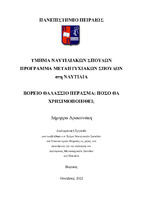Βόρειο Θαλάσσιο Πέρασμα: πόσο θα χρησιμοποιηθεί;
Northern Sea Route: how much will be used?

Προβολή/
Λέξεις κλειδιά
Βόρειο θαλάσσιο πέρασμα ; Αρκτική ; Ρωσία ; Northern Sea Route ; Πάγος ; Εναλλακτική διαδρομή ; Παγοθραυστικά ; Ice classΠερίληψη
Τα τελευταία χρόνια χαρακτηρίζονται από μια συνεχόμενη ροή πληροφοριών και ανακαλύψεων στον τομέα της Ναυτιλίας. Όλο και περισσότεροι επαγγελματίες του κλάδου καταβάλουν προσπάθειες ώστε να προσφέρουν υπηρεσίες υψηλής ποιότητας. Μέσα σε αυτό το πλαίσιο έχει προκληθεί ιδιαίτερο ενδιαφέρον για μία θαλάσσια διαδρομή, η οποία ενώνει τον Ειρηνικό με τον Ατλαντικό ωκεανό, την Ευρώπη με την Ασία μειώνοντας το χρόνο ταξιδίου σχεδόν κατά το ήμισυ. Πρόκειται για το Βόρειο θαλάσσιο πέρασμα, το οποίο μέχρι το έτος 2050 εκτιμάται ότι δεν θα έχει εξελιχθεί σε μια ανοιχτή δίοδο, διαθέσιμη στη ναυσιπλοΐα για όλο το χρόνο παρά το επιχείρημα της μείωσης του πάγου στην Αρκτική. Τα τυπικά φορτηγά πλοία μπορούν να κάνουν χρήση του περάσματος με συνοδεία παγοθραυστικού και έχοντας απαραιτήτως ice class notation, αφού ο όγκος του πάγου σε ορισμένα σημεία του περάσματος μπορεί να δημιουργήσει προβλήματα. Αυτά μπορεί να αναγκάσουν το πλοίο είτε να επιμηκύνει το ταξίδι του, αυξάνοντας τα λειτουργικά έξοδα και αθετώντας όρους του ναυλοσυμφώνου, είτε να κάνει αναστροφή και να μην φτάσει στον τελικό του προορισμό. Σύμφωνα με μελέτες, θα παραμείνει έως το 2050 μια εποχική θαλάσσια λωρίδα που είναι επικίνδυνη για πλοία με χαμηλές κατηγορίες πάγου και θα είναι διαθέσιμη για πλοήγηση μόνο για ένα σύντομο χρονικό διάστημα. Για τα φορτηγά πλοία είναι απίθανο να ανταγωνιστεί επιτυχώς την παραδοσιακή ναυτιλιακή διαδρομή μέσω της Διώρυγας του Σουέζ που συνδέει την Ευρώπη με τις χώρες της Άπω Ανατολής καθώς είναι πολλά τα θέματα που χρήζουν επίλυσης. Το 2030 η αναμενόμενη προσβασιμότητα στο πέρασμα προβλέπεται να διαρκέσει από ένα έως δύο μήνες, ενώ το 2090 εκτιμάται να φτάσει τους πέντε μήνες. Επιπλέον, τα πλοία που πλέουν στο NSR θα πρέπει να συμμορφώνονται με τα συνιστώμενα τμήματα διαδρομής αλλά και με τη νομοθεσία που ορίζει η Ρωσία, καθώς βρίσκεται υπό τον έλεγχο της. Μέχρι το τέλος του 21ου αιώνα αναμένεται η αύξηση του όγκου των εμπορευμάτων που διακινούνται μεταξύ Κίνας και Ευρωπαϊκής Ένωσης και το NSR είναι πιθανό να αποτελέσει εναλλακτική δίοδο για την αποσυμφόρηση των παραδοσιακών θαλάσσιων διαδρομών. Παρά ταύτα, η συγκεκριμένη διαδρομή αντιμετωπίζει σοβαρά προβλήματα (κλιματολογικά, οικονομικά κ.α) που την καθιστούν μη λειτουργική και σίγουρα μη επιλέξιμη.


